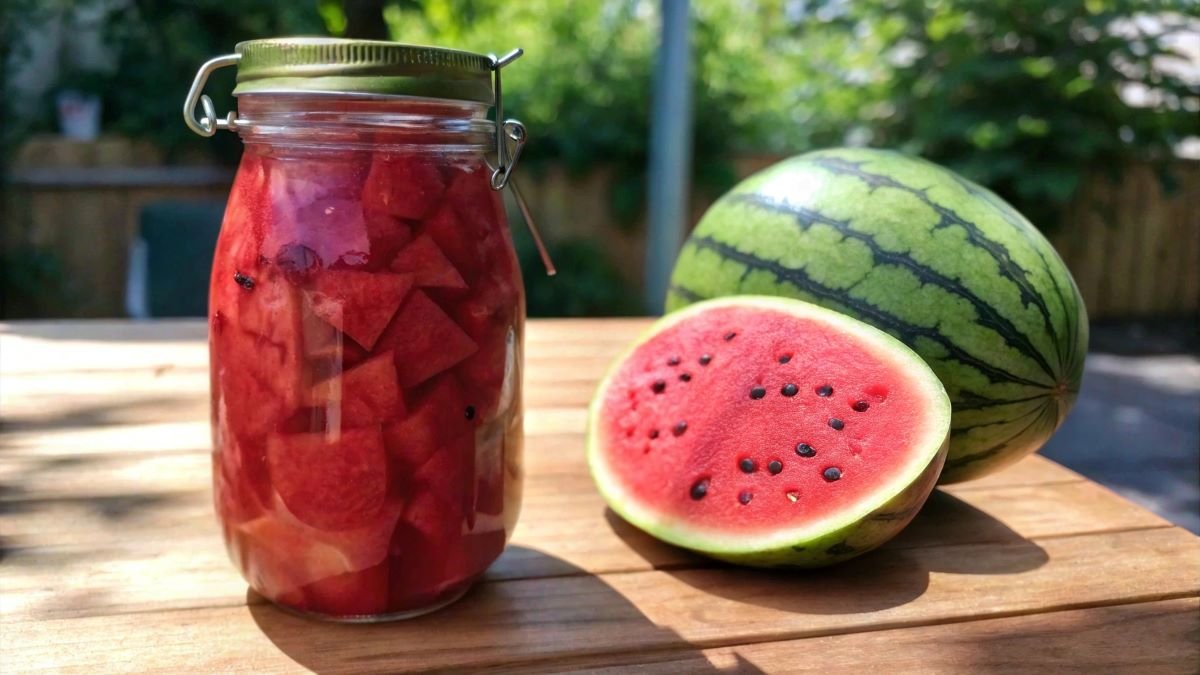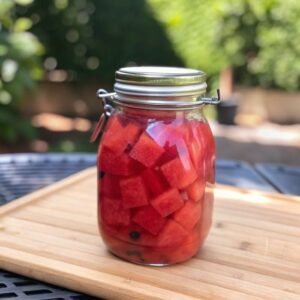Fermented Watermelon Recipe: Step by Step
Cultural history of watermelons, the science behind fermentation, and how to create this unique treat at home.

Fermenting watermelons is an easy way to enjoy this summer favorite beyond its typical season. By fermenting the fruit, you can enhance its flavor, extend its shelf life, and gain additional health benefits due to the fruits fermentation.
In this post, we’ll explore the cultural history of watermelons, the science behind fermentation, and how to create this unique treat at home.
Fermented Watermelon Recipe

Fermented Watermelon
Equipment
- 1 Glass jar (2-liter capacity) Clean, not sterilized
- 1 Lid or fermentation lid To seal the jar
- 1 Weight or small plate To keep the watermelon submerged
- 1 Mixing bowl For preparing the brine
- 1 Measuring spoon For measuring salt
- 1 Cutting Board
- 1 Sharp knife
Ingredients
- 450 grams watermelon Cut into bite-sized pieces
- 2 pieces Hot pepper Optional, adjust for desired spiciness
- 2 tsp mustard seeds Optional
- 3 pieces fresh dill sprigs or 1 teaspoon dried dill (optional).
- 2 pieces Cherry leaves Optional, for preserving crunchiness
- 1 liter Filtered water Non-chlorinated
- 1 tbsp Pickling salt Sea salt, Himalyan or Celtic Salt preferred
- 2 pieces Lemon or lime slices Optional, for added flavor
Instructions
Preparation
- Prepare the Watermelon: Cut the watermelon into bite-sized chunks. If fermenting rind pickles, peel the rind and cut it into strips.
- Prepare the Jar: In a clean jar, layer hot pepper, lemon or lime slices, mustard seeds, dill springs and cherry leaves (if using).
Brine Preparation
- Mix the Brine: In a mixing bowl, dissolve 1 tablespoon of pickling salt in 1 liter of filtered water. Stir until completely dissolved.
Assembling
- Add Watermelon to Jar: Fill the jar with watermelon chunks, leaving about 1 inch of headspace at the top.
- Pour in the Brine: Pour the brine over the watermelon, ensuring all pieces are submerged.
- Weight it Down: Use a weight or small plate to keep the watermelon fully submerged in the brine.
- Seal the Jar: Cover the jar with a lid or a fermentation-specific lid to allow gas to escape.
Fermenting
- Leave at Room Temperature: Place the jar on the kitchen counter and let it ferment for 3 days. Check daily to ensure the watermelon remains submerged. Taste on the 3rd day and decide if more fermentation time is needed for your preferred flavor.
Storage
- Refrigerate: Once the desired tanginess is achieved, transfer the jar to the refrigerator. Consume within 1-2 weeks for optimal freshness.
Notes
- Choose ripe but firm watermelon: Overripe watermelon may ferment too quickly or become mushy.
- Optional cherry leaves: These act as a natural tannin, helping to preserve crispness in both the watermelon flesh and rind pickles.
- Experiment with flavors: Add spices like mustard seeds or herbs like dill for a unique twist.
- Check the brine level daily: Add more brine if necessary to keep the watermelon submerged.
- Room temperature matters: Ferment in a cool, dark spot to avoid overly rapid fermentation.
- Avoid metal equipment: Always use glass or food-safe plastic for fermentation to prevent reactions with the acidic brine.
- Fermentation time varies: Depending on room temperature, the watermelon may ferment faster or slower—taste and adjust as needed.
- Using the Rind: Don’t throw away the watermelon rind; it can be fermented separately to make crunchy pickles, reducing food waste and adding variety to your fermented foods
Nutritional Information (Per Serving)
| Nutrient | Amount |
|---|---|
| Calories | 20 kcal |
| Carbohydrates | 11 g |
| Sugars | 9 g |
| Fiber | 1 g |
| Protein | 1 g |
| Fat | 0 g |
| Sodium | 290 mg |
| Vitamin A | 865 IU |
| Vitamin C | 12 mg |
| Potassium | 170 mg |
Note: These nutritional values are approximate and can vary based on specific ingredients used.
What causes a watermelon to ferment?
Fermentation is a natural process where microorganisms like bacteria and yeast convert sugars into other compounds, such as acids or alcohol.
In the case of watermelon, the fermentation happens because of naturally occurring bacteria and yeast present on the fruit’s surface and in the environment.
When you create the right conditions – like adding salt and submerging the watermelon in brine – you encourage beneficial microbes to grow while suppressing harmful ones.
Here’s how watermelon-fermentation works:
- Lactic Acid Bacteria Take Over: Lactic acid bacteria (LAB), which are already present on the watermelon and in the air, are the main players in this process. These bacteria thrive in low-oxygen, salty environments that other harmful microbes can’t tolerate. Salt inhibits the growth of unwanted bacteria while allowing LAB to thrive. This creates a safe environment for fermentation.
- Conversion of Sugars into Lactic Acid: The lactic acid bacteria consume the natural sugars in the watermelon and convert them into lactic acid. This lowers the pH of the brine, making it more acidic. The increasing acidity acts as a natural preservative, protecting the watermelon from spoilage.
- Probiotic Development: As the LAB (lactic acid bacteria) continue working, they produce beneficial compounds such as probiotics. Fermentation can also enhance the bioavailability of nutrients like lycopene and vitamin C, making them easier for your body to absorb.
- Suppression of Spoilage Organisms: Now, because the environment becomes salty and acidic, harmful bacteria and fungi can’t survive. Meanwhile, the good bacteria (LAB) multiply and dominate the environment.
Cultural History of Watermelons
Watermelons have a rich history dating back over 5,000 years to southern Africa, where they thrived in arid regions like the Kalahari Desert. [1]

Initially, these fruits were valued for their ability to store water, essential for survival in dry climates. Unlike today’s sweet varieties, early watermelons had bitter flesh and were primarily used for their hydrating properties.
As watermelons spread to Egypt, they underwent cultivation improvements. Seeds and paintings found in ancient Egyptian tombs, some over 4,000 years old, depict oval-shaped watermelons, indicating early agricultural advancements. [2]
Over time, the fruit became sweeter and more palatable, eventually becoming a global favorite.
In various cultures, watermelons symbolize abundance, joy, and fertility. They are often featured in communal gatherings and celebrations, embodying generosity and community spirit.
Frequently Asked Questions
Final Words
So, there you have it folks, an easy to prepare fermented watermelon recipe. Let me know how you’re doing, and if you have any questions. Feel free to subscribe to comments to get notified when I answer your questions.
In the meantime, feel free to learn more about the Benefits of Watermelon as well as checking other fermenting recipes such as:
- How To Make Fermented Bok Choy Recipe
- Fermented Fruit Juice Recipe (FFJ): How To Make At Home
- How to Make Fermented Celery (Pickled): Recipe + Tips
- How To Make Fermented Quinoa (Recipe)
- Recipe: How to make fermented ratfish liver oil?
- How To Make Fermented Cabbage (Sauerkraut Recipe)
- How To Make Lacto-Fermented Eggplant Recipe
- Fermented Salmon Recipe (Pa’awk)
